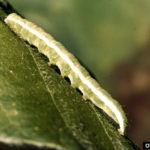Velvetbean Caterpillar Defoliating Soybeans in Piedmont
go.ncsu.edu/readext?555951
en Español / em Português
El inglés es el idioma de control de esta página. En la medida en que haya algún conflicto entre la traducción al inglés y la traducción, el inglés prevalece.
Al hacer clic en el enlace de traducción se activa un servicio de traducción gratuito para convertir la página al español. Al igual que con cualquier traducción por Internet, la conversión no es sensible al contexto y puede que no traduzca el texto en su significado original. NC State Extension no garantiza la exactitud del texto traducido. Por favor, tenga en cuenta que algunas aplicaciones y/o servicios pueden no funcionar como se espera cuando se traducen.
Português
Inglês é o idioma de controle desta página. Na medida que haja algum conflito entre o texto original em Inglês e a tradução, o Inglês prevalece.
Ao clicar no link de tradução, um serviço gratuito de tradução será ativado para converter a página para o Português. Como em qualquer tradução pela internet, a conversão não é sensivel ao contexto e pode não ocorrer a tradução para o significado orginal. O serviço de Extensão da Carolina do Norte (NC State Extension) não garante a exatidão do texto traduzido. Por favor, observe que algumas funções ou serviços podem não funcionar como esperado após a tradução.
English
English is the controlling language of this page. To the extent there is any conflict between the English text and the translation, English controls.
Clicking on the translation link activates a free translation service to convert the page to Spanish. As with any Internet translation, the conversion is not context-sensitive and may not translate the text to its original meaning. NC State Extension does not guarantee the accuracy of the translated text. Please note that some applications and/or services may not function as expected when translated.
Collapse ▲
Clemson University – Some velvetbean caterpillars are green. USDA Cooperative Extension Slide Series, Bugwood.org
I’ve had several reports of velvetbean caterpillar out of the Piedmont area. This is a migratory insect that we usually only see in coastal counties late (after September), but probably blew farther inland courtesy of hurricane Florence. Velvetbean caterpillars are voracious feeders and can stem a field in a weekend. Any beans that are not yet at R7 could be at risk for yield loss if the defoliation is severe enough. Also, under severe defoliation and the absence of leaves, caterpillars can turn their attention to pods, clipping them. Therefore, it is critical to protect fields with high numbers of caterpillars, especially fields that are not close to maturity.

Some velvetbean caterpillars are brown or almost black. Steve L. Brown, University of Georgia, Bugwood.org
They can easily be controlled with a variety of insecticides listed on p. 92 in the NC Agricultural Chemicals Manual. Sometimes these caterpillars are confused with armyworms, but they have a forked tail and, when disturbed, wriggle violently. They also lack the patterning on the head and “spots” on the side of the body characteristic of many armyworms. More information on identification can be found in the Soybean Insect Guide.


